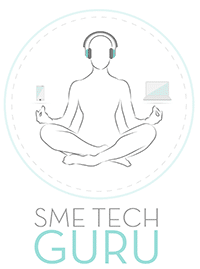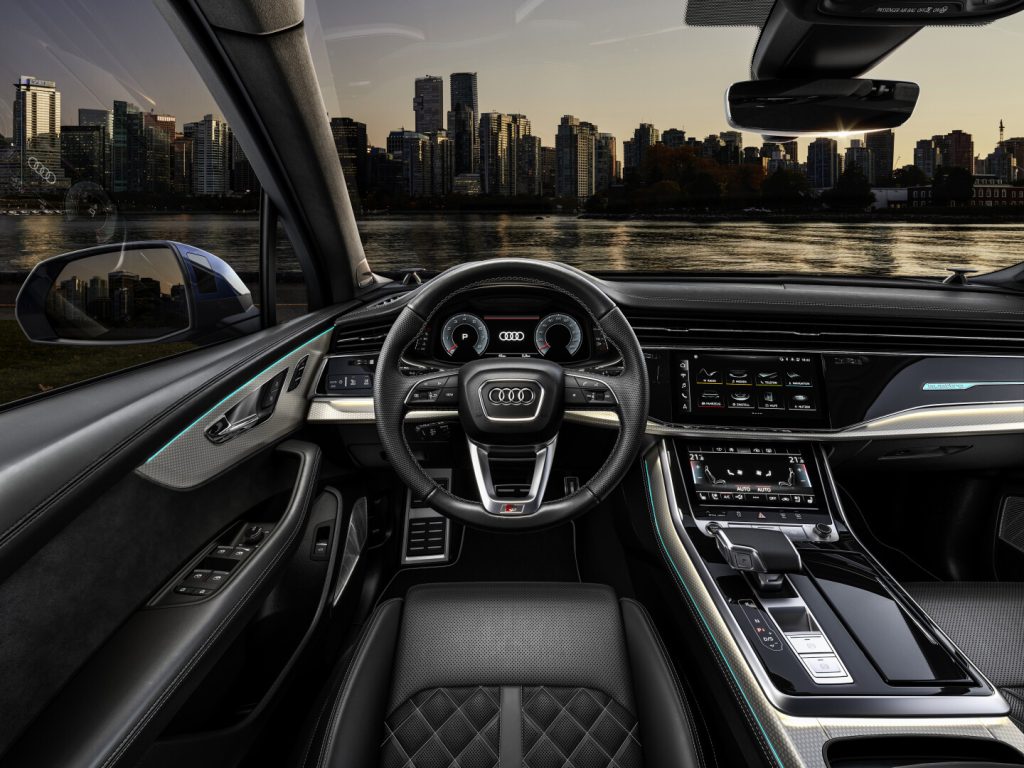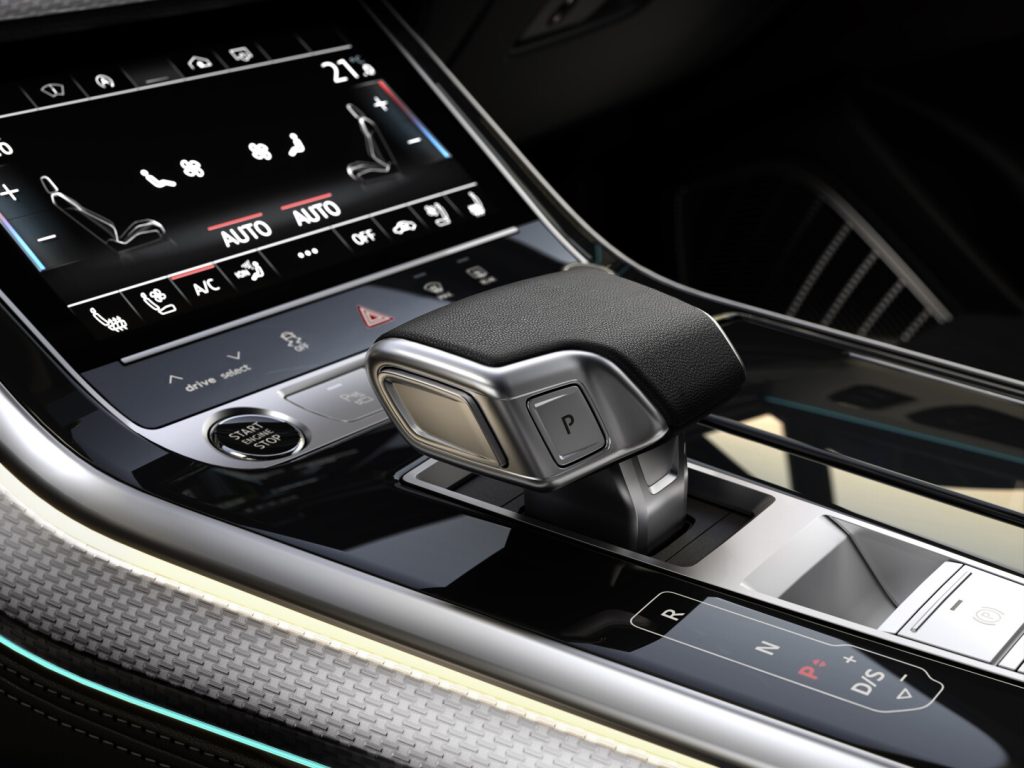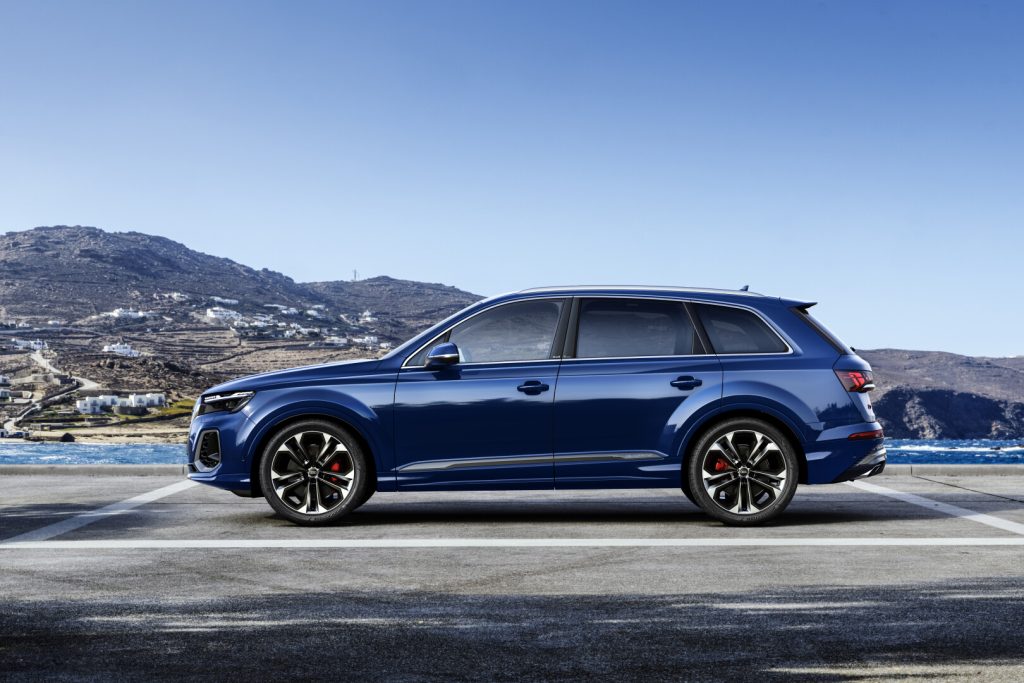Audi has once again upgraded its flagship SUV with a clear visual language and even better technology. The fresh exterior design with new front and rear sections underscores the powerful character of the SUV, which offers first-class versatility and generous space for up to seven passengers. For the first time in a Q7, the HD Matrix LED headlights with laser as an additional high beam sport digital daytime running lights with selectable light signatures. Digital OLED rear lights with four selectable light designs complete the offering. New wheel, colours, decorative inlays and seats with contrast stitching lend the Q family’s most versatile SUV an even higher level of customisability.
From a study to a successful production model
The Audi Q7’s journey of success began in 2003 as a concept car called the Audi Pikes Peak quattro at the North American International Motor Show. Conceived as a vehicle suitable driving on all roads and moderate off-road use, the Q7 – which has been delighting customers worldwide for 18 years – remains true to its virtues of design, technology, and functionality. The first SUV from the brand with the four rings was unveiled to the public at the 2005 Frankfurt Motor Show (IAA), just in time for the 25th anniversary of the quattro permanent four-wheel drive system. The new “superlative” in the SUV segment, as Audi put it at the launch of the Q7, combined poise, sportiness, and versatility. Since its launch, the Audi Q7 has been viewed as an all-rounder that combines high prestige with a wide range of applications.
Powerful, spacious, elegant: the exterior
Following the launch of the second generation with all-wheel steering in 2015 and an initial product upgrade in 2019, the new Q7 impressively shows its robust and elegant design with this second, comprehensive upgrade. With its even more minimalist form, clean surfaces, and exceptionally large volume, the Q7 stands for adaptability in every situation.
The overhangs and wheelbase demonstrate powerful and confident proportions that are further emphasised by distinctive exterior colours and wheels. The unmistakably upright Audi Singleframe with an octagon design now boasts vertical inlays. This makes it clear at first glance that the vehicle is an Audi top model and differentiates it from the A models. In addition, the new interplay between the grille’s contours and the headlights, now positioned slightly higher, makes for a completely new front-end architecture that clearly emphasises the powerful and more present appearance of the new Q7. The Q7’s self-confident appearance is underscored by the new prominent, colour-framed air intakes, which are clearly integrated into the vehicle’s basic architecture.
Customisability at its best: headlights and rear lights
High-intensity Matrix LED headlights light up the road as standard. HD Matrix LED headlights with the Audi laser light are also available. They work with 24 LEDs and a high-power laser diode each and are immediately recognisable via a blue ambient light incorporated into the headlights that symbolises the precision of laser technology. The laser light becomes active above 70km/h and significantly increases the high beam range.
New for the top-of-the-range headlights are digital daytime running light signatures. They give the Q7 its characteristic and unmistakable appearance by allowing the user to select one of four various light signatures via the MMI. However, not just the headlights’ extended range of functions is new; so too is their design. The higher position of the daytime running lights gives the Q7 a wider appearance and more expressiveness. For the first time, the Q7 also features digitalised OLED rear lights (OLED = organic light emitting diode) as an option, which also feature four digital light signatures.
In addition – as in the recently revealed Audi A5, facelifted Q8, and all-new Q5 – the digital OLED rear lights have a proximity indication feature in conjunction with the assistance systems: When other road users approach the stationary Q7 from behind to within two metres, the control units automatically activate all the digital OLED segments to alert the driver of the following car. Additional functions include dynamic turn signals as well as various coming home and leaving home sequences that match each digital light signature.
Safe on every surface: suspension with Audi’s DNA
Only an Audi drives like an Audi: This is how the brand with the four rings sums up the DNA of an Audi’s on-road characteristics, and it’s no less true for the Q7. Five characteristics define the Q7’s handling: balanced, solid, controlled, precise, and effortless. The suspension, steering, drive and braking and control systems all play a key role in creating a reliably safe, confident, and comfortable driving experience.
Electronically controlled air suspension with a continuously adaptive damping system – adaptive air suspension or adaptive air suspension sport (standard equipment on the SQ7 TFSI) – are included. Depending on the driver’s preferences and the driving situation, the suspension adjusts the ride height by up to 90mm while also offering level control. On the highway, the suspension lowers automatically by up to 30mm, depending on the current speed, and by 15mm with adaptive air suspension sport. During off-road driving, the “Lift” function in Audi drive select can be used to increase the ground clearance by up to 60mm at low speeds.
In addition, all-wheel steering (standard equipment on the SQ7 TFSI) ensures an increased level of safety and comfort. At low speeds, the back wheels turn up to five degrees in the opposite direction to the front wheels. This reduces the turning radius by up to one metre and increases manageability. At the same time, the driver feels more comfort and stability at higher speeds because the back wheels turn in the same direction as the front wheels.
Efficient and powerful: drive systems
The range opens with the Q7 55 TFSI featuring a six-cylinder petrol engine with three litres of displacement and direct fuel injection that delivers 250kW. It produces a maximum torque of 500Nm in a broad rev range from 1,370 to 4,500rpm. The Audi Q7 55 TFSI accelerates from zero to 100km/h in 5.6 seconds. It reaches its electronically governed top speed at 250km/h.
Sportiness is deeply rooted in the genes of the new SQ7 TFSI. It now runs on the established four-litre TFSI with 373 kW and 770 Nm of torque with fast-shifting eight-speed tiptronic and quattro permanent all-wheel drive. With this engine, the SQ7 TFSI accelerates from zero to 100km/h in just 4.1 seconds, with an electronically governed top speed of 250km/h. With its firing order of 1-3-7-2-6-5-4-8, the 4.0 TFSI provides a distinctively sporty, sonorous sound.
Versatile and spacious: the interior
Both the five- and seven-seat versions of the Audi Q7 and SQ7 TFSI combine high prestige with everyday practicality. With their generous length, headroom, and elbowroom front and back, both vehicles offer a first-class, airily spacious atmosphere. Depending on the position of the rear backrests, the luggage compartment in the five-seat version offers a volume of between 867 litres (backrests up) and 1,993 litres (backrests down). The tailgate is electrically powered as standard.
The best Q7 yet, now available
The market launch of the Audi Q7 takes place this month. Audi South Africa will offer the 55 TFSI in Platinum Edition and Black Edition trim lines. The SQ7, meanwhile, can be specified in with the Black Edition trim line, which includes a Black styling package plus, Black mirror housings, a Singleframe surround in black, as well as privacy glazing for the rear windows.
Prices for the 55 TFSI quattro start at R1,958,000 for the Platinum Edition and R1,987,900 for the Black Edition. The SQ7’s pricing will be revealed nearer its local market launch in January 2025. Like all Audi models, the new Q7 boasts a 5-year/100,000km Audi Freeway Plan comprehensive service and maintenance plan.






